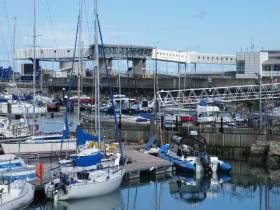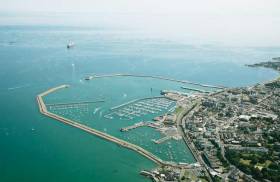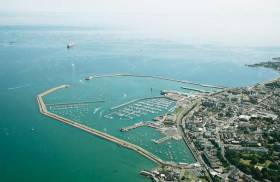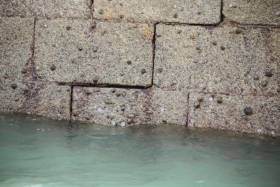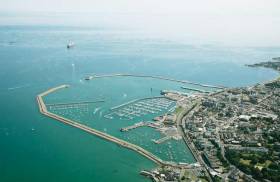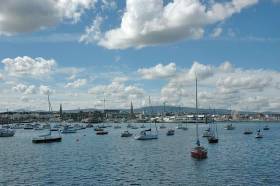Displaying items by tag: dlrcoco
Harbour Company ‘A Gift and A Jewel’ for Dun Laoghaire Locals
#DLharbour - People in Dún Laoghaire Rathdown are getting “a gift and a jewel” in the transfer of the Dún Laoghaire Harbour company to the county council, Minister for Transport Shane Ross has insisted.
As The Irish Times reports, the Minister confirmed that he had on Wednesday formally signed the transfer of the harbour company’s functions to the county council.
Mr Ross rejected claims that the company had €33 million in liabilities and insisted it was closer to €10 million which would extend over a long period of time for repairs and maintenance.
He stressed that it will not affect local property tax or local projects and the transfer included a “seven-digit cash reserve”.
The Minister was speaking during a heated Seanad debate on the company’s transfer.
“It’s a gift and a jewel being given to the people of Dún Laoghaire Rathdown,” he said. “This is a great deal for the citizens and residents.”
For more the newspaper reports here in addition Afloat this week revealed a cruiseship from Norwegian Cruise Line is to call during the 2019 season totalling six calls.
Harbour Transfer ‘A Kick In The Teeth’ To Dun Laoghaire Residents, Council Session Hears
#DLHarbour - Councillors in Dun Laoghaire-Rathdown have expressed anger and frustration over the transfer of Dun Laoghaire Harbour Company’s multi-million liabilities to the local authority.
Transport Minister Shane Ross was in the Seanad this afternoon for statements on the transfer of functions of the harbour company to Dun Laoghaire-Rathdown County Council (DLRCoCo), which was made formal today (Wednesday 3 October) after he signed off on the move last week.
DLRCoCo later held a Special Meeting to debate the transfer, at which Councillor Cormac Devlin said the debt “will have a significant impact on future council budgets and may lead to reduced services and increases in commercial rates and the Local Property Tax.
“The chief executive of the council confirmed to members that the figure of €33m may actually be at the lower end of the scale of liabilities. This directly contradicts Minister Shane Ross’ claim to the Seanad that the debt is only €10m.”
Cllr Devlin called on the Government to “find a way to indemnify the council to ensure residents and business owners do not suffer for their policies.”
Councillor Dónal Smith was even more vociferous, branding Minister Ross’ lack of a promise of indemnity as “a kick in the teeth for the people who elected him. He has hung a financial albatross around the necks of his constituents. He will not be thanked.”
Cllr Smith said suggestions that the council sell public lands earmarked for housing to pay down the harbour’s debts amount to “a scandal”.
“If Fine Gael gives a toss about the residents and ratepayers of Dún Laoghaire-Rathdown, their Government will indemnify the council,” he added.
Update on Thursday 4 October: The full Special Meeting can be streamed in full from DLRCoCo's webcast player HERE.
Community Projects ‘In Jeopardy’ As Local Authority Takes On Dun Laoghaire Harbour Debts
#DLHarbour - Dun Laoghaire-Rathdown county councillors have suggested a potential increase in Local Property Tax to help offset Dun Laoghaire Harbour Company’s multi-million-euro liabilities, now that the harbour has been officially transferred to local authority control.
Cllr Barry Ward tweeted late last night (Wednesday 26 September) that Transport Minister Shane Ross had signed over responsibility for Dun Laoghaire Harbour “with no financial provision for the estimated €33.5 million debt now imposed on his own constituents, despite repeated calls for fairness from councillors.
“[Dun Laoghaire-Rathdown] cannot sustain this level of financial liability,” he added.
Minister @Shane_RossTD has tonight signed @DLHarbour over to @dlrcc with no financial provision for the estimated €33.5 million debt now imposed on his own constituents, despite repeated calls for fairness from councillors. DLR cannot sustain this level of financial liability. pic.twitter.com/DYENREpcv8
— Barry Ward (@barrymward) September 26, 2018
A slew of projects and developments in the Dun Laoghaire-Rathdown area — from Stillorgan Library to Glenalbyn Swimming Pool to the Marlay Park Masterplan — are now “all in jeopardy”, according to local councillor Barry Saul.
Glenalbyn Pool , Stillorgan Library , Marley running track , Fernhill Phase 2, Marley Park Masterplan all in jeopardy following Minister Ross decision to sign over DL Harbour and 33 million liabilities to Dun Laoghaire Rathdown Council pic.twitter.com/H1DDwI5J9E
— Barry Saul (@cllrbarrysaul) September 26, 2018
Cllr Lynsey McGovern added that “we can kiss goodbye to keeping commercial rates and property tax down now,” while Cllr Jim Gildea said even a 30% increase in LPT “would only give us €15m. I for one couldn’t vote to hoist that burden on our householders”.
Minister Ross confirmed back in April this year that “all assets and liabilities” of Dun Laoghaire Harbour Company would transfer to the local authority upon the former’s dissolution — and made clear that National Ports Policy does not provide for Exchequer funding “for any port company”.
The transfer of liabilities was branded as “unacceptable” at the time by local Green Party councillor Ossian Smyth.
Independent Senator Victor Boyhan was set to raise the issue of the harbour transfer and its financial implications for DLRCoCo in the Seanad this morning, as previously reported on Afloat.ie.
Update Friday 28 September: Cllr Barry Ward tweeted confirmation that Dun Laoghaire Harbour will come under control of Dun Laoghaire-Rathdown County Council next Wednesday 3 October.
Fine Gael councillors have called for a special meeting on the issue on the same day at 5pm. An invitation will be extended to Transport Minister Shane Ross.
The transfer order for @DLHarbour has been signed by Minister @Shane_RossTD. #DúnLaoghaire #Harbour will now come under the controll of @dlrcc on Wednesday next, 3 October. The Council was informed by letter yesterday. pic.twitter.com/SwGC9LLJ6c
— Barry Ward (@barrymward) September 28, 2018
Dun Laoghaire Harbour Transfer In Final Stages
#DLHarbour - Dun Laoghaire County Council is currently involved in final negotiations over the takeover of Dun Laoghaire Harbour.
In his response to a Dáil question on the timeline for transfer of the port to the local authority, Transport Minister Shane Ross confirmed that the order of transfer was sent to the Department of Housing, Planning and Local Government in mid July.
This followed issues relating to risk assessment that were “clarified at meetings that took place between the relevant officials” in the council and harbour company executive since March.
Local residents in Dun Laoghaire also met over the summer to establish any “common concerns” that may be presented to the harbour’s new overseers.
Afloat.ie understands that the final negotiations are centring on the harbour company's liabilities, which local Green Party councillor Ossian Smyth branded as “unacceptable” in April this year.
#DublinBay - Proposals to turn the former Dún Laoghaire Ferry Terminal into a “digital technology hub” which could support up to 1,000 jobs and 50 companies has received planning permission.
The Irish Times writes that the project’s developer, Philip Gannon, says he intends to invest €20 million to transform the abandoned building on St Michael’s Pier into the “harbour innovation campus”. It will be the largest technology hub in Ireland and one of the five largest in Europe, he said.
Dún Laoghaire-Rathdown County Council granted permission on Tuesday for the project to go ahead.
The ferry terminal has lain empty since 2015 when sailings ceased. Under the terms of the planning permission the outside of the building will remain the same while the 7,000 square metre interior will be transformed into a campus for technology companies, similar to the Digital Hub in Dublin city centre.
For further reading on the development, click here.
#DLHarbour - Solicitors for Dun Laoghaire Harbour Company called for the retraction of “damaging and disparaging statements” made at a council meeting on the transfer of the port to local authority control, it has emerged.
According to today’s Sunday Times (6 May), the solicitors claimed that remarks by four Dun Laoghaire-Rathdown councillors at the meeting on 6 March “call into question the proper governance and management of the company.”
Mason Hayes & Currin repeated their demand on 16 March to DLRCoCo chair Tom Murphy, who replied that he was not responsible for statements made by other councillors in meetings, which are in general under qualified privilege.
Read more on this story from the The Sunday Times (behind the paywall).
Minister Says ‘No Immediate Health & Safety Issue’ In Dun Laoghaire Harbour Despite West Pier Damage
#DLHarbour - “There is no immediate health and safety issue with any pier in Dun Laoghaire.”
That was the message from Transport Minister Shane Ross in his reply to a Dáil question from local TD Richard Boyd Barrett earlier this week.
On the question of the risk assessment and due diligence reports conducted on Dun Laoghaire Harbour Company, Minister Ross said the process “is a matter for” the chief executive of Dun Laoghaire-Rathdown County Council, who concluded last month “that the most appropriate model for the [harbour] company is the transfer and dissolution model.”
The minister confirmed earlier this month that “all assets and liability” of Dun Laoghaire Harbour Company would transfer to the local authority.
“I understand that the main issue now outstanding relates to remedial works in the harbour and how those works will be funded,” said Minister Ross in his response to Deputy Barrett, reiterating that National Ports Policy “clearly states that there is no Exchequer funding for any port company.
“My Department has been informed that there is no immediate health and safety issue with any pier in Dun Laoghaire,” he continued.
The statement comes after recent concerns over damage to the West Pier after Storm Emma, as previously reported on Afloat.ie.
Minister Confirms ‘All Assets & Liabilities’ Of Dun Laoghaire Harbour Company Will Transfer To Local Authority
#DLHarbour - “All assets and liabilities” of Dun Laoghaire Harbour Company will transfer to the local authority upon its pending dissolution — with no additional State funding available, the Minister for Transport has confirmed.
Shane Ross was responding in writing to a parliamentary question from local independent county councillor Michael Merrigan, which asked the minister to specify if any funding would be provided “to create a reserve to assist Dun Laoghaire-Rathdown County Council in outstanding liabilities as part of a final agreement of transfer”.
“National Ports Policy recognised that the future of Dun Laoghaire port lies in marine leisure, marine tourism, cultural amenity and urban redevelopment,” Minister Ross wrote. “In addition, it clearly states that there is no Exchequer finding for any port company.”
Dún Laoghaire Hbr. transfer to @dlrcc - reply to PQ on approx. €33.5 million burden on residents & businesses in county. @Shane_RossTD - Minister for Transport (AND Closed Garda Stations, Demolished Swimming Pools & Judicial Appointments) needs to clarify funding! pic.twitter.com/fqVGCA1B5H
— Michael Merrigan (@VoteMerrigan) April 18, 2018
Confirming that the existing port company’s assets and liabilities would transfer to DLRCoCo, the minister added that “the port will continue to generate income from marine-related and other activities such as rents, leases and car parks”, and that any remedial and engineering works “are normally prioritised” and funded via planned allocations.
Cllr Merrigan’s question raised concerns that Dun Laoghaire Harbour company’s financial liabilities “are greater than its liquid assets” and that the transfer comes with “risks and potential exposure” to the local authority.
The minister “needs to clarify funding” on the foot of a “€33.5 million burden on residents and businesses” in the county, the councillor added.
Last week, local Green Party councillor Ossian Smyth said the transfer of liabilities to the local authority is “not acceptable”.
#DLHarbour - The proposal by Transport Minister Shane Ross to transfer Dun Laoghaire Harbour’s liabilities to the local authority along with its assets is “not acceptable”, according to a local councillor.
Last Monday 9 April, Green Party Cllr Ossian Smyth shared the news that the minister had decided the “responsibility for the future of the port” lies with Dun Laoghaire-Rathdown County Council, in line with National Ports Policy.
Local campaigners broadly welcomed the news after a long period of uncertainly over the port’s future, with People Before Profit TD Richard Boyd Barrett hailing the decision as a victory for “people power”.
But now concerns have been raised with the particulars of Minister Ross’ letter to DLRCoCo chief executive Philomena Poole, in which he states that his “preferred model of transfer is that of dissolution of [Dun Laoghaire Harbour Company] and the transfer of all assets, liabilities and employees to the County Council.”
Cllr Smyth told Afloat.ie: “Dun Laoghaire’s taxpayers should not be left on the hook for debts accumulated by the harbour company while pursuing far-fetched projects like the super cruise ship berth, the floating hotel and floating homes, a hotel on the Carlisle Pier and so on.”
Govt Urged To Avoid Delay In Dun Laoghaire Harbour Transfer
#DLHarbour - Transport Minister Shane Ross must ensure there is “no delay” in the transfer of Dun Laoghaire Harbour to the local authority, as Dublin Live reports.
Earlier this week it emerged that Minister Ross had made his determination that the “responsibility for the future of the port lies with DLR County Council”.
The move is being hailed as a victory for “people power” by People Before Profit TD Richard Boyd Barrett, a long-time local campaigner for bringing the harbour under public control.
Minister Ross is set to meet with the chief executive of Dun Laoghaire-Rathdown County Council to discuss the dissolution of Dun Laoghaire Harbour Company and the transfer of its assets to the local authority.
“[Successive Transport Ministers’] failure to act has meant that significant liabilities have built up and a lot of public money has been wasted,” said Deputy Boyd Barrett.
“The Government needs to now stump up the money needed to cover these liabilities, while ensuring no delay in the transfer of the harbour into full public control.”
Meanwhile, DLRCoCo has signed a €9 million contract for the long-awaited redevelopment of the Dun Laoghaire Baths adjacent to the harbour, as previously reported on Afloat.ie.



























